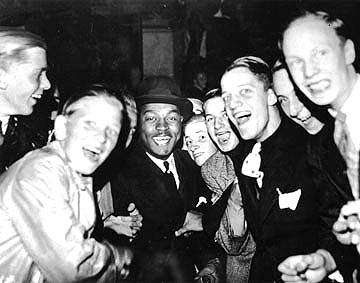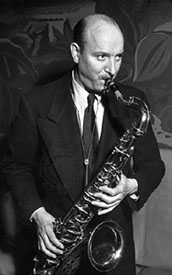
Benny Carter with young fans, 1937. Photo courtesy Rutgers Institute for Jazz Studies.
At the dawn of jazz in early 20th century New Orleans, players like trombonist Kid Ory and cornetist King Oliver taught themselves how to play or learned informally from other musicians. Many worked day jobs on the docks, or as servants. First generation jazz musicians created a driving, rhythmic style that caught on around the country. But it was a relatively simple music—you might have called it ‘urban folk music.’
Though early New Orleans jazz lacked the spit and polish of technical proficiency, jazz soloists of the Swing Era declared this territory their battleground. These 'Heroes of Swing' won their medals with precise intonation and the ability to play fast, clean runs with absolute accuracy in both low and very high ranges. As author John McDonough wrote in “Streamlining Jazz: Major Soloists of the 1930s and 40s” in The Oxford Companion to Jazz, “In the struggle to outgrow its origins, jazz became caught up in an arms race of virtuosity that took the solo form from folk art and popular art to the portals of high art.”
Just as King Oliver was the visionary who wrote the rules on what ensemble-style jazz bands should sound like, his protégée Louis Armstrong led the pack on defining the art of the jazz soloist.
And ever since Louis Armstrong recorded his first spectacular jazz solo inventions in the 1920s, the music has revolved around stellar solo playing. Louis Armstrong and reedman Sidney Bechet were among the first jazz players to define their art with equal emphasis on technical expertise, dazzling solos and passionate performances. But by the mid 1930s, their influence was heard in a new generation of jazzmen, in some cases using formal musical training to expand the language of jazz, inventing new rhythms and more daring harmonies. The results thrilled audiences.
This week Riverwalk Jazz salutes the great soloists of the 1930s, who propelled jazz to a new level. We’ll hear the music of two Irish-American brothers from Pennsylvania who shared a drive for musical perfection—Jimmy and Tommy Dorsey; as well as the work of the self-taught, European gypsy guitarist Django Reinhardt, whose solo playing re-invented jazz guitar. Also on the bill is music from a trio of highly inventive reedmen—Benny Goodman, Bud Freeman, and Benny Carter.
Photo credit for Home Page: Times Square New York, 1938. Photo courtesy Louis Armstrong House & Archives, Queens College.
Text based on Riverwalk Jazz script by Margaret Moos Pick ©2012



